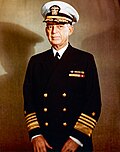Wikipedia:Today's featured article/requests/Thomas C. Kinkaid
Thomas C. Kinkaid
[edit]This nomination predates the introduction in April 2014 of article-specific subpages for nominations and has been created from the edit history of Wikipedia:Today's featured article/requests.
- The following discussion is an archived discussion of the TFAR nomination of the article below. Subsequent comments should be made on the appropriate discussion page (such as Wikipedia talk:Today's featured article/requests). Please do not modify this page unless you are renominating the article at TFAR. For renominations, please add
{{collapse top|Previous nomination}}to the top of the discussion and{{collapse bottom}}at the bottom, then complete a new {{TFAR nom}} underneath.
The result was: scheduled for Wikipedia:Today's featured article/April 3, 2013 by BencherliteTalk 15:28, 26 March 2013 (UTC)
Thomas C. Kinkaid (1888–1972) was an admiral in the United States Navy during World War II. Born into a naval family, he graduated from the U.S. Naval Academy in 1908. He saw action during the 1916 occupation of the Dominican Republic, and in World War I, when he was attached to the Royal Navy. During World War II, his cruisers defended the aircraft carriers USS Lexington during the Battle of the Coral Sea and USS Hornet during the Battle of Midway. He then took command of Task Force 16, built around the carrier USS Enterprise, during the long and difficult Solomon Islands campaign. He commanded the North Pacific Force during operations that regained control of the Aleutian Islands. In November 1943, he became Commander Allied Naval Forces in the Southwest Pacific Area, and Commander of the Seventh Fleet, directing U.S. and Australian forces supporting the New Guinea and the Philippine campaigns, during which he conducted numerous amphibious operations. He commanded an Allied fleet during the Battle of Leyte Gulf, the last naval battle between battleships. He continued in service after the war until his retirement in 1950. (Full article...)
4 points: 2 points as this would be his 125th birthday + 2 points for the article being promoted more than two years ago (in November 2010). Hawkeye7 (talk) 02:11, 15 February 2013 (UTC)
- Trimmed to below the 1,200 limit, and further c/e per the instructions (no full names, link the article at the start). BencherliteTalk 21:30, 16 February 2013 (UTC)
- Hi; I've given the article a fairly close read, and have a few quibbles:
- In the section "Early career", beginning of second paragraph a sentence reads, "Students had to undertake to remain in the Navy for at least eight years." Undertake what? This sentence makes no sense to me. Perhaps you mean "students had to commit to remaining in the Navy..." or better: "students incurred an eight-year commitment to stay in the Navy."
- Changed to "commit" Hawkeye7 (talk) 23:34, 16 February 2013 (UTC)
- "Kinkaid now faced the prospect of selection to rear admiral. He knew that captains normally required command experience to be considered, but it was unlikely that a billet as captain of a battleship or cruiser would come up in sufficient time before the next round of selections." This doesn't make sense, because at the very end of the section entitled "Between the wars" Kincaid had been "given his second seagoing command, the heavy cruiser USS Indianapolis" Clarification is needed here, because it appears that he should have had the command experience needed for the promotion.
- Added a clarification. Hawkeye7 (talk) 23:34, 16 February 2013 (UTC)
- In "Southwest Pacific" section, paragraph 3 it reads, "With 215 vessels involved, Operations Reckless and Persecution in April 1944 was the largest operation in New Guinea waters." While this might be technically correct, it is awkward to equate something plural with something singular. Recommend something like "...Operations Reckless and Persecution in April 1944 jointly resulted in the largest operation in New Guinea waters." Sarnold17 (talk) 22:28, 16 February 2013 (UTC)
- Re-worded. Hawkeye7 (talk) 23:34, 16 February 2013 (UTC)
- In the section "Early career", beginning of second paragraph a sentence reads, "Students had to undertake to remain in the Navy for at least eight years." Undertake what? This sentence makes no sense to me. Perhaps you mean "students had to commit to remaining in the Navy..." or better: "students incurred an eight-year commitment to stay in the Navy."
- Support An important figure in the Pacific War. Sarnold17 (talk) 00:21, 17 February 2013 (UTC)
- NB Battle of the Bismarck Sea, another Pacific War article, is TFA for 3rd March. As it's not "within" 1 month (it's exactly 1 month!) of this request I don't think it gives a points penalty, but with possibly a German WWII triple-header in March as well, I think [mental note to self, at the very least] we need to lay off the WWII articles for the rest of March! BencherliteTalk 21:11, 18 February 2013 (UTC)
- I see Carmen as being in the queue for 3 March; I don't find the battle article anywhere in the lineup. Am I missing something?--Sarnold17 (talk) 23:30, 18 February 2013 (UTC)
- See Wikipedia:Today's featured article/March 3, 2013. It was Carmen, it's been changed in the last couple of hours, so Purge your cache if you still see Carmen somewhere. BencherliteTalk 23:34, 18 February 2013 (UTC)
- (ec) Carmen was replaced by the battle. Another plan for April 3 was Neville Cardus, born the very same day and year, writer on cricket and music - by the author of Carmen, in the pending list for a while. - I miss that list on this page, but at least it is on the talk, --Gerda Arendt (talk) 23:40, 18 February 2013 (UTC)

